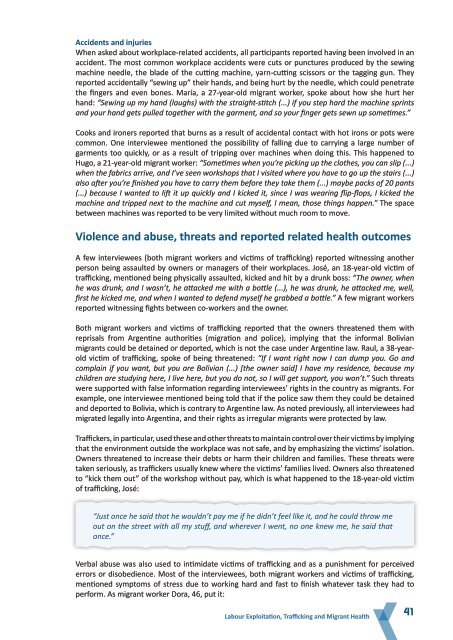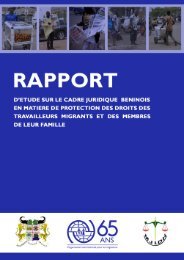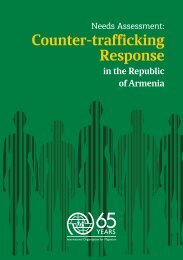Labour Exploitation Trafficking and Migrant Health
labour_exploitation_trafficking_en_0
labour_exploitation_trafficking_en_0
You also want an ePaper? Increase the reach of your titles
YUMPU automatically turns print PDFs into web optimized ePapers that Google loves.
Accidents <strong>and</strong> injuries<br />
When asked about workplace-related accidents, all participants reported having been involved in an<br />
accident. The most common workplace accidents were cuts or punctures produced by the sewing<br />
machine needle, the blade of the cutting machine, yarn-cutting scissors or the tagging gun. They<br />
reported accidentally “sewing up” their h<strong>and</strong>s, <strong>and</strong> being hurt by the needle, which could penetrate<br />
the fingers <strong>and</strong> even bones. María, a 27-year-old migrant worker, spoke about how she hurt her<br />
h<strong>and</strong>: “Sewing up my h<strong>and</strong> (laughs) with the straight-stitch (...) if you step hard the machine sprints<br />
<strong>and</strong> your h<strong>and</strong> gets pulled together with the garment, <strong>and</strong> so your finger gets sewn up sometimes.”<br />
Cooks <strong>and</strong> ironers reported that burns as a result of accidental contact with hot irons or pots were<br />
common. One interviewee mentioned the possibility of falling due to carrying a large number of<br />
garments too quickly, or as a result of tripping over machines when doing this. This happened to<br />
Hugo, a 21-year-old migrant worker: “Sometimes when you’re picking up the clothes, you can slip (...)<br />
when the fabrics arrive, <strong>and</strong> I’ve seen workshops that I visited where you have to go up the stairs (...)<br />
also after you’re finished you have to carry them before they take them (...) maybe packs of 20 pants<br />
(...) because I wanted to lift it up quickly <strong>and</strong> I kicked it, since I was wearing flip-flops, I kicked the<br />
machine <strong>and</strong> tripped next to the machine <strong>and</strong> cut myself, I mean, those things happen.” The space<br />
between machines was reported to be very limited without much room to move.<br />
Violence <strong>and</strong> abuse, threats <strong>and</strong> reported related health outcomes<br />
A few interviewees (both migrant workers <strong>and</strong> victims of trafficking) reported witnessing another<br />
person being assaulted by owners or managers of their workplaces. José, an 18-year-old victim of<br />
trafficking, mentioned being physically assaulted, kicked <strong>and</strong> hit by a drunk boss: “The owner, when<br />
he was drunk, <strong>and</strong> I wasn’t, he attacked me with a bottle (...), he was drunk, he attacked me, well,<br />
first he kicked me, <strong>and</strong> when I wanted to defend myself he grabbed a bottle.” A few migrant workers<br />
reported witnessing fights between co-workers <strong>and</strong> the owner.<br />
Both migrant workers <strong>and</strong> victims of trafficking reported that the owners threatened them with<br />
reprisals from Argentine authorities (migration <strong>and</strong> police), implying that the informal Bolivian<br />
migrants could be detained or deported, which is not the case under Argentine law. Raul, a 38-yearold<br />
victim of trafficking, spoke of being threatened: “If I want right now I can dump you. Go <strong>and</strong><br />
complain if you want, but you are Bolivian (...) [the owner said] I have my residence, because my<br />
children are studying here, I live here, but you do not, so I will get support, you won’t.” Such threats<br />
were supported with false information regarding interviewees’ rights in the country as migrants. For<br />
example, one interviewee mentioned being told that if the police saw them they could be detained<br />
<strong>and</strong> deported to Bolivia, which is contrary to Argentine law. As noted previously, all interviewees had<br />
migrated legally into Argentina, <strong>and</strong> their rights as irregular migrants were protected by law.<br />
Traffickers, in particular, used these <strong>and</strong> other threats to maintain control over their victims by implying<br />
that the environment outside the workplace was not safe, <strong>and</strong> by emphasizing the victims’ isolation.<br />
Owners threatened to increase their debts or harm their children <strong>and</strong> families. These threats were<br />
taken seriously, as traffickers usually knew where the victims’ families lived. Owners also threatened<br />
to “kick them out” of the workshop without pay, which is what happened to the 18-year-old victim<br />
of trafficking, José:<br />
“Just once he said that he wouldn’t pay me if he didn’t feel like it, <strong>and</strong> he could throw me<br />
out on the street with all my stuff, <strong>and</strong> wherever I went, no one knew me, he said that<br />
once.”<br />
Verbal abuse was also used to intimidate victims of trafficking <strong>and</strong> as a punishment for perceived<br />
errors or disobedience. Most of the interviewees, both migrant workers <strong>and</strong> victims of trafficking,<br />
mentioned symptoms of stress due to working hard <strong>and</strong> fast to finish whatever task they had to<br />
perform. As migrant worker Dora, 46, put it:<br />
<strong>Labour</strong> <strong>Exploitation</strong>, <strong>Trafficking</strong> <strong>and</strong> <strong>Migrant</strong> <strong>Health</strong><br />
41





